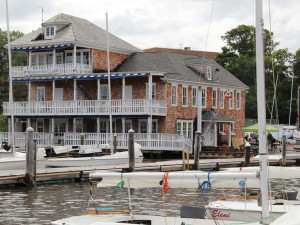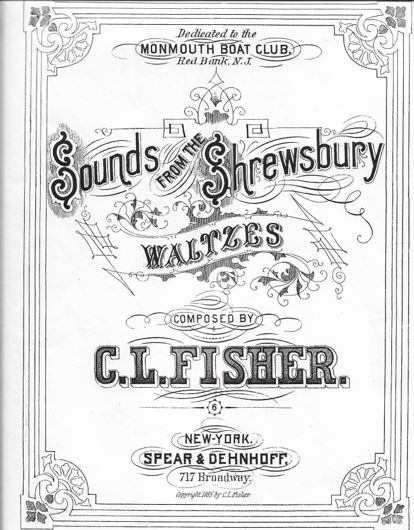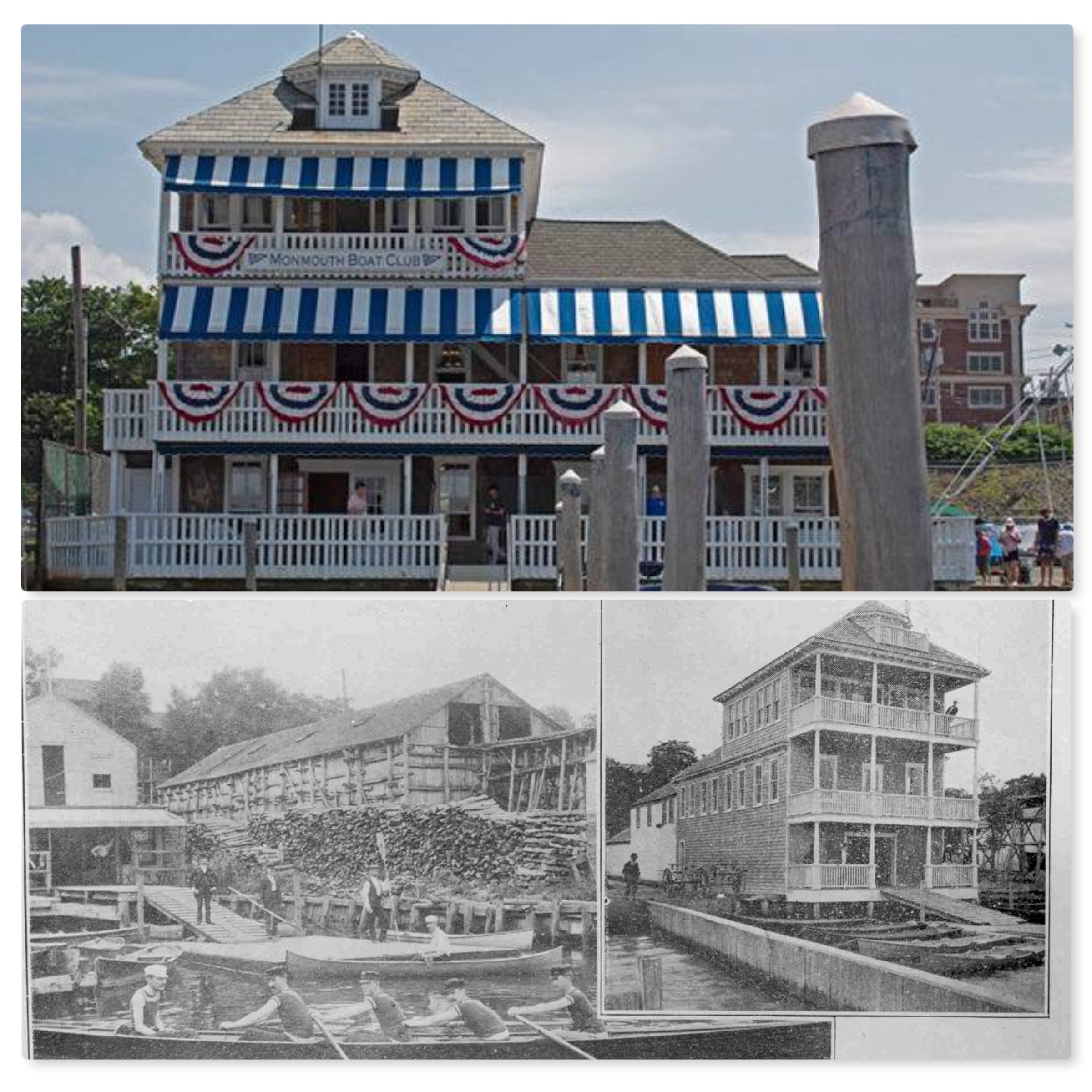
(Left side of B/W pic) A four-oared barge with coxswain and single Ruston-type canoe pose in front of the old club house. The firwood and shed at the right of the house are part of John A. Worthley’s coal and wood yard.
(Right side of B/W pic) When the new Monmouth Boat Club was built in the summer of 1895, the lagoon in front of the old club was bulkheaded and filled, piling was driven and the new 25x50 foot building constructed on it. The old building was then moved 35 feet closer to the river and attached to the back of the new and ground floor was opened through. All of the work cost ‘nearly $4000. This is considerably more than it was intended at the first expend…’ commented the Red Bank Register. The new building was built by Charter Member Archibald Antonides.
The History
Founded in 1879, Monmouth Boat Club is located in Red Bank, New Jersey, near the head of the beautiful Navesink River. It is an informal and friendly organization whose members are drawn together by a love of sailing and rowing and an appreciation of the charm of our idyllic river. The Club is run and maintained entirely by its members, resulting in a close spirit of cooperation and camaraderie.
MBC was originally founded as a rowing club at the time when paddle wheel steamboats and packet sailing ships maintained an active trade between Red Bank and New York City, and commercial fishing and the oyster industry flourished on the Navesink. Though much has changed along the waterfront over the years, Monmouth Boat Club has remained a constant force promoting recreation on the river. Sailing has been the major focus of the Club since Word War I. Currently, there are five active one-design classes, an enthusiastic cruising fleet and a variety of small craft used for day-sailing and gunk-holing. The one-design classes include Lightnings, Albacores, Flying Scots, Wood Pussys, and Sanderlings.
MBC members and club historians over the years have amassed a significant collection of historic art and artifacts, including 14 paintings, of which four are originals; more than 50 trophies and other racing memorabilia that trace the history of watersports on the Navesink River over the past 150 years; some 200 photographs from the late 19th and early 20th centuries illustrating the wide variety of activities that have characterized the Navesink River over the decades; and archival documents including original MBC founding papers, and important correspondence relating to things like the club's participation in the America's Cup.
The Fleets
Fleets are formed based on the interests of the members. Throughout the history of the Club, many fleets have been represented. And now, MBC has come full circle – it once again includes rowers. In November 2000, a rowing fleet was formed.
| THE CLUB HOUSEThe Club has been situated in the same historic clubhouse for more than 100 years. The house, with its three tiers of porches, provides an ideal spot for relaxing while viewing the activities on the river, socializing, or watching the sun set over the hills of the northwest shore of the river on a balmy summer evening. The house is surrounded by a boat yard where members’ boats of under twenty feet in length are stored on racks or trailers. The Club maintains three hoists for launching and has three two-hundred foot floating docks, including a low dock for rowers. Over fifty moorings for the cruising fleet are a short row from the docks. |
THE SAILING TRADITION
Over the years, members of the Club have distinguished themselves in the sailing world at competition levels ranging from regional and national class championships in junior and senior levels to the Olympic. These include the Adam’s Cup, the O’Day Trophy, the USYRU Single-handed and Double handed Women’s Sailing Championships, the Martini & Rossi Trophy for Yachtswoman of the Year, and a Gold Medal at the Pan American Games.
DID YOU KNOW…In 1885 a composition of 6 waltzes by C.L. Fisher was dedicated to our club?
Sheet music entitled Sounds from the Shrewsbury “Dedicated to the Monmouth Boat Club Red Bank, N.J.” was composed by C.L. Fisher and published by Spear & Dehnhoff, 717 Broadway, New York in 1885. This work is on file in the Library of Congress and is part of the musical collections entitled: Music for the Nation: American Sheet Music, Ca. 1870 to 1885; The Library of Congress Celebrates the Songs of America.
Little is known by this writer about the composer C.L. Fisher and why MBC and the Shrewsbury were the inspiration for his waltzes. Was he a member? Did Fisher travel to Red Bank on holiday or to enjoy the festivities of the winter carnivals? We have photographic proof participants of the Winter Carnivals danced on the frozen river. Perhaps we have a reader and historical sleuth who’d like to solve some of the mystery surrounding this treasure.
(Click here or on the score sheet to see the full composition in .pdf)

In the meantime, have a listen to an excerpt of the 10 minute presentation of waltzes.
Or sit back and enjoy the full score of waltzes and imagine yourself taking a spin on the dance floor.
My thanks to my daughter Jossalyn, and her family for recording this piece and especial thanks to Jubilee’s piano instructor who brought to life this difficult musical gem after over a century of silence.
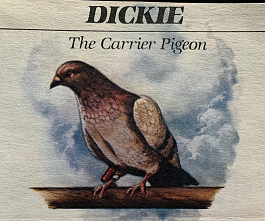 Jersey's very own Telegraph Carrier Pigeon DICKIE
Jersey's very own Telegraph Carrier Pigeon DICKIE
In 1850 Dickie, the carrier pigeon, was commissioned to assist Captain Farrell at Western Union’s 70 foot observation tower in Sandy Hook. Captain Farrell scanned the ocean for inbound transatlantic ships. Once identified by code signals, he’d telegraph the Maritime Association in Manhattan to expect a specific ship. Now began Dickie’s job. The bird was taken by small boat to meet the ship where the latest news bulletins from Europe were waiting. The news was tied to the pigeon’s leg and Dickie flew back to the tower. There the news would was relayed by telegraph to New York and the nation.
Well... maybe... Dickie was quite an "unique and independent little fellow." Sometimes Dickie decided to antagonize poor Captain Farrell by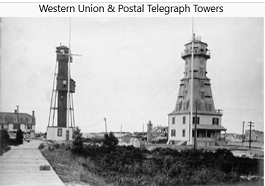 strutting just out of arm’s reach around the tower ledge. Teasing the Captain mercilessly as only a Jersey pigeon could do. “And so, it happened.” Scribner’s Magazine concluded, “that all of America, yearning for news of the Old World, waited on the caprice <whim> of Dickie, the carrier pigeon.”
strutting just out of arm’s reach around the tower ledge. Teasing the Captain mercilessly as only a Jersey pigeon could do. “And so, it happened.” Scribner’s Magazine concluded, “that all of America, yearning for news of the Old World, waited on the caprice <whim> of Dickie, the carrier pigeon.”
Dickie’s reign of torment for poor Captain Farrell and the rest of the nation ended around 1858 when he was declared surplus once the new transatlantic telegraph cable became operational.
What’s in a Name? North Shrewsbury or Navesink or Navisink or Nave Sinck? The Navesink, or Navisink, (or Nave Sinck) were a group of Lenape Native Americans who inhabited the Raritan Bayshore near Sandy Hook and Mount Mitchill in eastern New Jersey. Their territory included the peninsula, as well as the highlands south of it, where they lived along its cliffs and creeks. Early settlers referred to the body of water by the original inhabitants' name, perhaps to distinguish it from the river to the south. The North Shrewsbury River includes the Swimming River estuary, which flows into the Navesink just north of Red Bank continuing ENE to Rumson joining the Shrewsbury River traveling to Sandy Hook Bay. Take a look at the maps below to see how the name changes. In 1781 John Hills, Surveyor and Engineer in the service of King George III sent this map to Sir Henry Clinton, General and Commander of the British Troops in America and identifies the river as the North or Navisink Harbour. The 1861 map refers to our home waters as THE Shrewsbury River with the estuary to the south as the South Shrewsbury. What’s in a name? To quote the great bard Shakespeare: 'A rose by any other name would smell as sweet' In the case of our river the best name for her is HOME.
Maps left to right: Mon.County 1781; 1781 name closeup; Mon.County 1851; 1851 name closeup; Mon.County 1861; 1861 name closeup
The River in Winter For more than 100 years the Navesink has been the venue for winter entertainment and invention. In the first installment of visions down "frozen" memory lane, look back at chilly yet bustling activities with MBC in the center of it all.
The 2nd and final installment we see transportation of all shapes and sizes used for sport, entertainment and commerce.
Resources: MBC Archives and the book "Up and Down the River" by June Methot
PAST ARTICLES
Iceboating and its legacy in New Jersey is under threat. See the video from USA Today.
Our thanks to MBC Member Ann Strang for sharing this article.
The Admiral's Barge for the Asbury Park Press site. Our thanks to MBC Member Joe Ruffini for actively preserving and sharing history with us.
